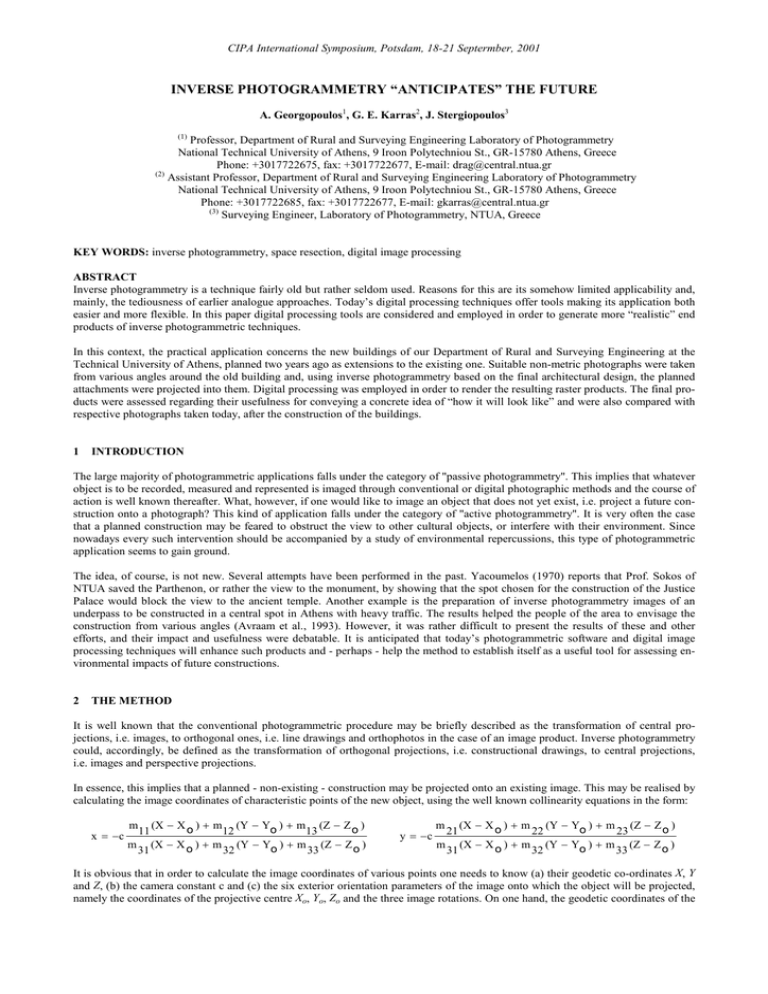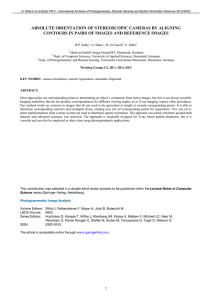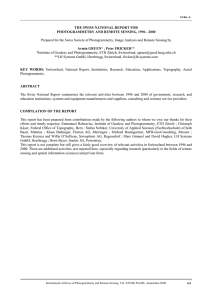INVERSE PHOTOGRAMMETRY “ANTICIPATES” THE FUTURE
advertisement

CIPA International Symposium, Potsdam, 18-21 Septermber, 2001 INVERSE PHOTOGRAMMETRY “ANTICIPATES” THE FUTURE A. Georgopoulos1, G. E. Karras2, J. Stergiopoulos3 (1) Professor, Department of Rural and Surveying Engineering Laboratory of Photogrammetry National Technical University of Athens, 9 Iroon Polytechniou St., GR-15780 Athens, Greece Phone: +3017722675, fax: +3017722677, E-mail: drag@central.ntua.gr (2) Assistant Professor, Department of Rural and Surveying Engineering Laboratory of Photogrammetry National Technical University of Athens, 9 Iroon Polytechniou St., GR-15780 Athens, Greece Phone: +3017722685, fax: +3017722677, E-mail: gkarras@central.ntua.gr (3) Surveying Engineer, Laboratory of Photogrammetry, NTUA, Greece KEY WORDS: inverse photogrammetry, space resection, digital image processing ABSTRACT Inverse photogrammetry is a technique fairly old but rather seldom used. Reasons for this are its somehow limited applicability and, mainly, the tediousness of earlier analogue approaches. Today’s digital processing techniques offer tools making its application both easier and more flexible. In this paper digital processing tools are considered and employed in order to generate more “realistic” end products of inverse photogrammetric techniques. In this context, the practical application concerns the new buildings of our Department of Rural and Surveying Engineering at the Technical University of Athens, planned two years ago as extensions to the existing one. Suitable non-metric photographs were taken from various angles around the old building and, using inverse photogrammetry based on the final architectural design, the planned attachments were projected into them. Digital processing was employed in order to render the resulting raster products. The final products were assessed regarding their usefulness for conveying a concrete idea of “how it will look like” and were also compared with respective photographs taken today, after the construction of the buildings. 1 INTRODUCTION The large majority of photogrammetric applications falls under the category of "passive photogrammetry". This implies that whatever object is to be recorded, measured and represented is imaged through conventional or digital photographic methods and the course of action is well known thereafter. What, however, if one would like to image an object that does not yet exist, i.e. project a future construction onto a photograph? This kind of application falls under the category of "active photogrammetry". It is very often the case that a planned construction may be feared to obstruct the view to other cultural objects, or interfere with their environment. Since nowadays every such intervention should be accompanied by a study of environmental repercussions, this type of photogrammetric application seems to gain ground. The idea, of course, is not new. Several attempts have been performed in the past. Yacoumelos (1970) reports that Prof. Sokos of NTUA saved the Parthenon, or rather the view to the monument, by showing that the spot chosen for the construction of the Justice Palace would block the view to the ancient temple. Another example is the preparation of inverse photogrammetry images of an underpass to be constructed in a central spot in Athens with heavy traffic. The results helped the people of the area to envisage the construction from various angles (Avraam et al., 1993). However, it was rather difficult to present the results of these and other efforts, and their impact and usefulness were debatable. It is anticipated that today’s photogrammetric software and digital image processing techniques will enhance such products and - perhaps - help the method to establish itself as a useful tool for assessing environmental impacts of future constructions. 2 THE METHOD It is well known that the conventional photogrammetric procedure may be briefly described as the transformation of central projections, i.e. images, to orthogonal ones, i.e. line drawings and orthophotos in the case of an image product. Inverse photogrammetry could, accordingly, be defined as the transformation of orthogonal projections, i.e. constructional drawings, to central projections, i.e. images and perspective projections. In essence, this implies that a planned - non-existing - construction may be projected onto an existing image. This may be realised by calculating the image coordinates of characteristic points of the new object, using the well known collinearity equations in the form: x = −c (X − X o ) + m (Y − Yo ) + m (Z − Z o ) 12 13 m (X − X o ) + m (Y − Yo ) + m (Z − Z o ) 31 32 33 m 11 y = −c (X − X o ) + m (Y − Yo ) + m (Z − Z o ) 22 23 m (X − X o ) + m (Y − Yo ) + m (Z − Z o ) 31 32 33 m 21 It is obvious that in order to calculate the image coordinates of various points one needs to know (a) their geodetic co-ordinates X, Y and Z, (b) the camera constant c and (c) the six exterior orientation parameters of the image onto which the object will be projected, namely the coordinates of the projective centre Xo, Yo, Zo and the three image rotations. On one hand, the geodetic coordinates of the CIPA International Symposium, Potsdam, 18-21 Septermber, 2001 characteristic points may be extracted from any kind of available plans or constructional drawings of the new object. One should only make sure that the reference system is a suitable one. On the other hand, for the calculation of the exterior orientation parameters of the image sufficient, suitably distributed, control points are necessary, provided they are in the same reference system as the object points. Interior orientation should also be known or assumed. In this way the selected characteristic points of the future object will be projected onto an image, or images if this is so desired, using the above collinearity equations. Such product could provide interested parties with a fairly good idea, from different viewpoints, of "how the object will look like" after construction. Provided the images have been taken from suitable angles, the effects of the construction may become even more obvious. 3 APPLICATION In order to investigate the direct applicability of the method described, but also to exploit current digital techniques, it was decided to embark on the following project. Since several years, two extensions to the existing building of the Department of Rural and Surveying Engineering of NTUA were planned. The constructional drawings were made available in 1996, a few years prior to the actual construction. The project would attempt to “realistically” project the buildings onto suitably taken photographs. For this purpose black and white images of the old building were acquired from selected spots of the area. Fortunately enough, there were tall buildings around, from which one could have clear views to the existing building and the areas where the future ones would be built. After recording, suitable control points were selected, in order to enable the space resection of images, and were transformed into the reference system used for the constructional plans. Figure 1. Two general views of the area. Above: initial images (1997), middle: processed images, below: today’s images. Using the geodetic coordinates of characteristic points of the new buildings extracted from the constructional plans, their image coordinates were calculated. Thus, it was possible to project the wire-frame of the new building on the images. This means that its position on each image and its realistic perspective deformation were also determined. The wire-frame in vector form was converted to CIPA International Symposium, Potsdam, 18-21 Septermber, 2001 raster form and inserted into the scanned initial images. Using simple digital processing tools available in commercial digital image processing software package, the wire-frame was suitably “painted” to produce the a possibly realistic final result. Figure 2. Two closer views of the area. Above: initial images (1997), middle: processed images, below: today’s images. For purposes of comparison corresponding images were taken recently, after the two extensions had been built. It becomes easily obvious that the method, as applied, has produced remarkable results, not so much in terms of accuracy, which in the present case is of no serious concern, but in terms of visual impression (Figs. 1, 2). It is very important to be able to show to interested parties how a final construction will look like with the help of means easily understandable such as an image. 4 CONCLUSIONS It has been shown that inverse photogrammetry is an active technique, which may in certain cases prove very useful. Probably its main advantage is the fact that high accuracy is not necessary, as it aims at providing the user with a general future view. For years it had been overlooked, maybe because of the difficulties of its application and also the not all that realistic results. However, it is obvious that modern digital image processing techniques have given a new potential to the method. It is hoped that with contributions of expertise in digital image processing, inverse photogrammetry could become a very useful tool for the protection of cultural heritage, and the environment in general. 5 REFERENCES Avraam, G., Karkatzounis, Ch., 1993. Inverse photogrammetry in highway design. Diploma Thesis, Dept. of Rural & Surveying Engineering NTUA (unpublished, in Greek). Yacoumelos, N.G., 1970. Reverse photogrammetric procedure in architectural design. Proceedings of ASP-ACSM Fall Convention, Denver, October 7-10.






